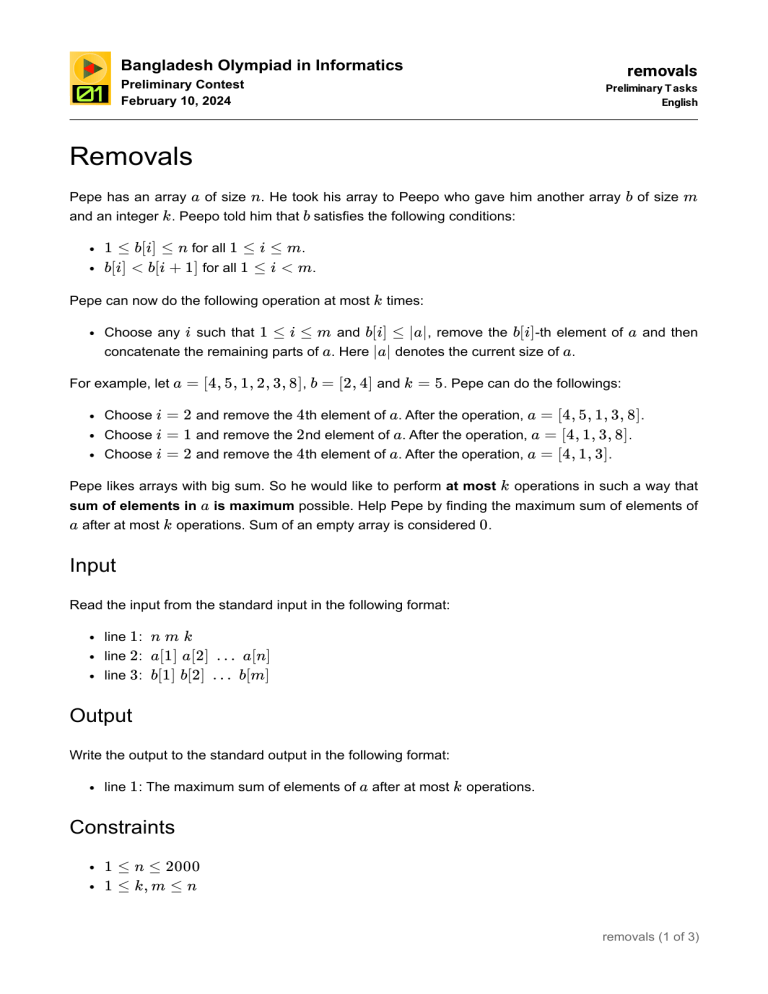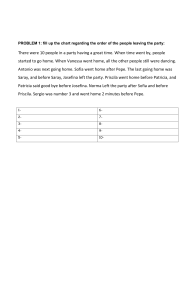
Bangladesh Olympiad in Informatics Preliminary Contest February 10, 2024 removals Preliminary T asks English Removals Pepe has an array a of size n. He took his array to Peepo who gave him another array b of size m and an integer k . Peepo told him that b satisfies the following conditions: 1 ≤ b[i] ≤ n for all 1 ≤ i ≤ m. b[i] < b[i + 1] for all 1 ≤ i < m. Pepe can now do the following operation at most k times: Choose any i such that 1 ≤ i ≤ m and b[i] ≤ ∣a∣, remove the b[i]-th element of a and then concatenate the remaining parts of a. Here ∣a∣ denotes the current size of a. For example, let a = [4, 5, 1, 2, 3, 8], b = [2, 4] and k = 5 . Pepe can do the followings: Choose i = 2 and remove the 4 th element of a. After the operation, a = [4, 5, 1, 3, 8]. Choose i = 1 and remove the 2 nd element of a. After the operation, a = [4, 1, 3, 8]. Choose i = 2 and remove the 4 th element of a. After the operation, a = [4, 1, 3]. Pepe likes arrays with big sum. So he would like to perform at most k operations in such a way that sum of elements in a is maximum possible. Help Pepe by finding the maximum sum of elements of a after at most k operations. Sum of an empty array is considered 0 . Input Read the input from the standard input in the following format: line 1 : n m k line 2 : a[1] a[2] … a[n] line 3 : b[1] b[2] … b[m] Output Write the output to the standard output in the following format: line 1 : The maximum sum of elements of a after at most k operations. Constraints 1 ≤ n ≤ 2000 1 ≤ k, m ≤ n removals (1 of 3) −10 9 ≤ a[i] ≤ 10 9 (for all 1 ≤ i ≤ n) 1 ≤ b[i] ≤ n (for all 1 ≤ i ≤ m) b[i] < b[i + 1] (for all 1 ≤ i < m) Subtasks 1. (5 points) m = 1 2. (13 points) n ≤ 18 3. (10 points) m, k ≤ 7 4. (18 points) m = 2 5. (14 points) b[m] ≤ b[1] + 18 6. (20 points) n ≤ 200 7. (20 points) No further constraints Examples Example 1 7 2 4 1 -5 4 -2 6 -5 1 2 4 The correct output is: 12 To maximize the sum, Pepe performs 3 operations: 1. First he chooses i = 2 . After this operation a = [1, −5, 4, 6, −5, 1]. 2. Then he chooses i = 1 . After this operation, a = [1, 4, 6, −5, 1]. 3. Finally he chooses i = 2 . After this operation, a = [1, 4, 6, 1]. The sum of elements in a is now 1 + 4 + 6 + 1 = 12 . It can be proven that a greater sum is not possible. Example 2 5 3 5 2 4 -2 -3 3 1 2 5 The correct output is: removals (2 of 3) 7 removals (3 of 3)




